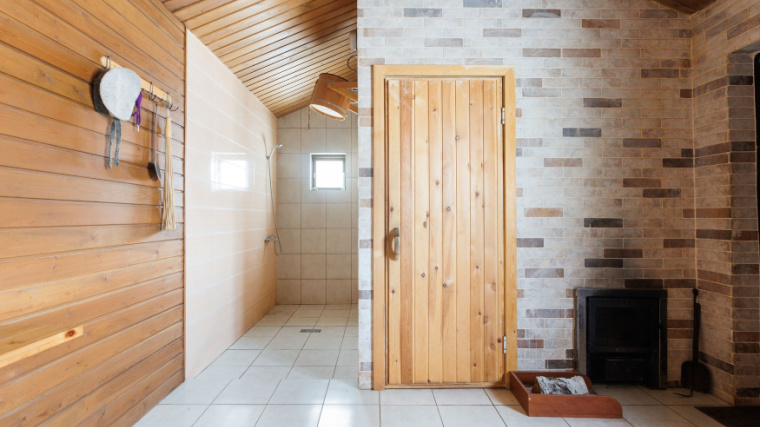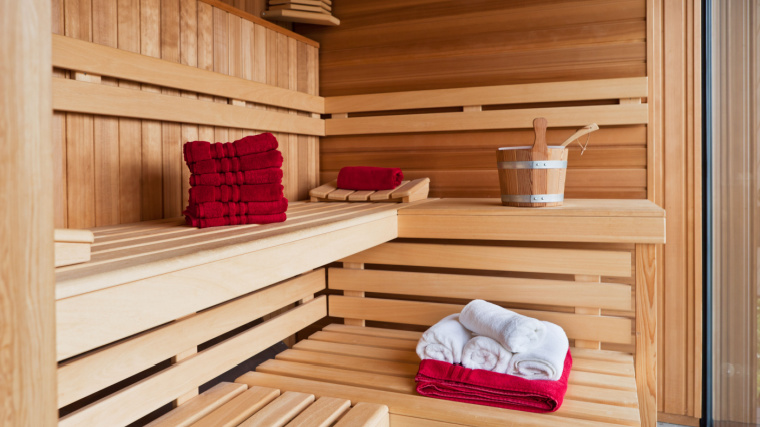Contrast therapy is so hot right now. Whether you’re a full-time cold water immersion fanatic who takes the plunge on a daily basis or you make the sauna the cornerstone of your active recovery protocols, exposing oneself to extreme temperatures is all the rage in health & fitness.
No matter what inspired you to dig into these modalities, the important part is that you understand the benefits — and risks — of utilizing facilities like a sauna or steam room. And, just so you know, they aren’t the same thing.

Here’s what you need to know about the differences (and similarities) between saunas and steam rooms so you can decide how to best get your sweat on.
Steam Room vs. Sauna
You can find saunas and/or steam rooms at most commercial gyms, spas, or resorts, and they generally serve the same purpose. Both saunas and steam rooms are dedicated spaces to briefly expose yourself to extreme heat.
Sauna as a practice is often attributed to Finnish culture. According to the North American Sauna Society, temperatures in your average sauna tend to sit between 150 and almost 200 degrees Fahrenheit.
[Read More: The 15 Best Home Gym Machines]
Steam rooms, sometimes known as Turkish baths, are a bit cooler and are usually between 110 and 120 degrees — but with nearly 100-percent humidity.
Key Differences
- While there are ‘wet saunas” that involve dripping water over hot rocks to create moisture in the air, most saunas are dry and arid like a desert while steam rooms are extremely humid.
- Saunas, on average, are warmer than steam rooms.
- Steam rooms are typically larger communal spaces, while saunas can be quite compact and intended for only 1 or 2 people at a time in some cases.
Key Similarities
- Both saunas and steam rooms are forms of heat therapy.
- Both practices are believed to have health benefits ranging from stress relief to cardiovascular regulation and more.
- Most large gyms or spas will have at least one or both rooms available.
Benefits of a Steam Room
While both steam rooms and saunas are intended to expose participants to extreme warmth, there are some key differences — and thus unique benefits — between them.
May Help With Circulation
There’s some evidence backing the idea that warm, humid air can improve blood flow. Certain studies have demonstrated the efficacy of “moist heat” dilates your blood vessels, allowing your heart to shuttle blood and nutrients around a bit quicker. (1)
Might Improve Congestion
The same mechanisms of the steam room that dilate blood vessels may also improve symptoms like nasal congestion, by dilating your airways and allowing you to inhale more smoothly through your nose.
Stress Relief
Heat exposure through a steam room or sauna has some support as a viable means of improving mental health. For example, some studies have asserted that heat exposure (sauna would count here as well) can reduce acute stress in people with highly-demanding jobs. (2)
Cons of a Steam Room
Steam rooms also come with some potential drawbacks. For instance, they’re often large communal spaces and can be surprisingly social environments. If you’re a solitary gymgoer and want to relax in silence after a hard strength training session, you may not find solace in a steam room.
The damp air of a steam room will also drench you in moisture much more quickly than a dry sauna would. After just five minutes, you’ll probably need a change of clothes. Also, some studies have alleged that the condensation on your skin may blunt some of the beneficial physiological effects achieved through perspiration. (3)

[Read More: 5 At-Home Workouts for Strength, Muscle Growth, Power, and More]
Moreover, while steam therapy is a common treatment for nasal congestion, you may not want to hit up a steam room while sick. Not only can you infect other patrons, but the high humidity is a stimulating environment for the growth of bacteria.
Benefits of a Sauna
Many of the benefits of steam rooms and saunas overlap. However, there are a few exclusive perks of a sauna that might convince you to opt into dry heat rather than damp.
General Relaxation
This perk applies to steam rooms too, unless you can’t stand the humidity of course. But there’s something to be said for the generally-relaxing experience of a short bout in the sauna. Sitting for 10 minutes in a dry sauna can help you clear your head and unwind after a hard workout.
[Read More: The 10 Best Cold Plunge Tubs for Muscle Recovery]
In a Jun. 30, 2022 episode of the Stronger by Science Podcast, researchers Greg Nuckols and Eric Trexler lent verbal support to the value of saunas for general relaxation. Trexler and Nuckols remarked that while some of sauna’s purported benefits don’t hold up to scientific scrutiny, “it’s nice to do things that feel nice.”
May Substitute for Exercise (in Limited Cases)
Make no mistake, a bout in the sauna can’t replace a good workout. However, researchers like Trexler do believe that the bodily effects of heat exposure through sauna can mildly replicate some of the effects of exercise for some people.
For example, a person who is unable to perform even moderate-intensity cardio may benefit from the increase in heart rate and perspiration facilitated by sauna exposure. Raising your heart rate also burns calories, both of which are helpful if you’re unable to do so by traditional means.
[Read More: Best Treadmills For Streaming, Folding, Running, And More]
One caveat here is that heat exposure increases cardiac output (that is, how hard your heart is working) without actually changing stroke volume, or the actual amount of blood being pumped. The latter tends to be the major contributing factor to physiological change.
In simple terms, this means that while sauna may make you feel similar to having performed a HIIT workout when you’re done, you won’t get all of the same benefits, especially if you’re already fit.
May Suppress Appetite
If you’ve ever gone for a swim in cool or chilly waters, you may have noticed an uptick in hunger afterwards. The inverse tends to happen when exposed to extreme heat, though. Research shows that heat exposure (through a sauna, steam room, or just a hot climate) can blunt appetite in some folks, (4) which can be useful if you’re trying to maintain a calorie deficit.
Cons of a Sauna
Sauna is far from a magic pill for a perfect bill of health. In addition to being generally uncomfortable for some people who can’t tolerate heat well, saunas may be impractical for you if you aren’t able to bring a change of clothes to the gym.
Physiologically, there aren’t as many cons to sauna as there is a limited body of evidence to support its would-be benefits. A landmark 2015 study (5) argued that frequent sauna usage significantly reduced all-cause mortality risks, but their findings were largely correlative, and didn’t establish a firm causative relationship.

[Read More: The 5 Best Fitness Trackers]
Moreover, the physiological benefits of sauna may be of limited relevance if you’re in good cardiovascular shape already specifically due to the increased cardiac load in the absence of higher stroke volume.
What the Science Says About Heat Exposure
Trexler and Nuckols regard sauna usage as producing “neutral to modestly positive” health outcomes — a verdict that aligns with what most modern research on heat exposure. Here are some of the effects you can expect from heat exposure via a sauna or steam room:
- Some rodent studies have shown that hyperthermic (as in, very hot) environments can accelerate tissue repair and bolster your antioxidant capacity. (6)
- Limited data have shown that heat exposure may help you maintain muscle mass if you’re not performing resistance training workouts, but these findings haven’t been widely replicated. (7)
- Heat exposure has anti-inflammatory properties, which may help remedy some conditions or be of particular use for those who can’t get the same effect from exercise. (8)
- Hyperthermic conditions have been shown to suppress appetite, which can be useful or detrimental depending on your nutritional goals. (4)
- Saunas and steam rooms both induce tremendous amounts of heat stress, which can pose dangerous risks depending on your medical history. (9)
Key Takeaways
In truth, saunas and steam rooms are far more alike than they are different. While some limited studies have pointed out key differences in efficacy, both saunas and steam rooms provide some wonderful health benefits if utilized properly.
However, you’re also at risk of dehydration and other maladaptive health effects if you indulge in heat exposure too frequently or for too long. Most of the factors that influence your choice between a steam room or sauna are logistical; do you have a spare change of clothes, do you prefer a more social or solitary environment, and so on.
FAQs
Here are some common questions about both steam rooms and saunas, along with helpful answers to put your concerns to rest.
Steam rooms and saunas are both designed to immerse you in extreme heat. Both fulfill this function and one isn’t better than another. If you prefer slightly less heat and more humidity, go for a steam room. If you want a hotter, drier environment, head to the sauna.
If you want to drop some weight quickly for a specific reason, you should head for a dry sauna. The moist air of a steam room may reduce your ability to shed water via sweating. Note, though, that steam rooms or saunas don’t create changes in body composition on their own; you won’t lose body fat just by sitting in a hot room, but you will drop water weight pretty quickly.
Saunas are considered “dry heat” most of the time and can be as hot as 150 degrees Fahrenheit. Steam rooms are a few degrees cooler and are extremely humid by comparison.
Most of the time, your choice of a steam room or a sauna comes down to personal preference. You aren’t likely to experience any drastically different outcomes, so you can simply pick whichever you have access to or is more comfortable.
Regardless of whether you want to use a steam room or a sauna, you should consult with your doctor before beginning, especially if you have any pre-existing medical conditions that may worsen as a result of heat exposure.
References
- Lohman EB 3rd, Sackiriyas KS, Bains GS, Calandra G, Lobo C, Nakhro D, Malthankar G, Paul S. A comparison of whole body vibration and moist heat on lower extremity skin temperature and skin blood flow in healthy older individuals. Med Sci Monit. 2012 Jul;18(7):CR415-24. doi: 10.12659/msm.883209. PMID: 22739731; PMCID: PMC3560772.
- Henderson KN, Killen LG, O’Neal EK, Waldman HS. The Cardiometabolic Health Benefits of Sauna Exposure in Individuals with High-Stress Occupations. A Mechanistic Review. Int J Environ Res Public Health. 2021 Jan 27;18(3):1105. doi: 10.3390/ijerph18031105. PMID: 33513711; PMCID: PMC7908414.
- Hussain J, Cohen M. Clinical Effects of Regular Dry Sauna Bathing: A Systematic Review. Evid Based Complement Alternat Med. 2018 Apr 24;2018:1857413. doi: 10.1155/2018/1857413. PMID: 29849692; PMCID: PMC5941775.
- Marriott BM, editor. Nutritional Needs in Hot Environments: Applications for Military Personnel in Field Operations. Washington (DC): National Academies Press (US); 1993. 10, Effects of Heat on Appetite
- Laukkanen, T., Khan, H., Zaccardi, F., & Laukkanen, J. A. (2015). Association between sauna bathing and fatal cardiovascular and all-cause mortality events. JAMA internal medicine, 175(4), 542–548.
- Naito, H., Powers, S. K., Demirel, H. A., Sugiura, T., Dodd, S. L., & Aoki, J. (2000). Heat stress attenuates skeletal muscle atrophy in hindlimb-unweighted rats. Journal of applied physiology (Bethesda, Md. : 1985), 88(1), 359–363.
- Selsby, J. T., Rother, S., Tsuda, S., Pracash, O., Quindry, J., & Dodd, S. L. (2007). Intermittent hyperthermia enhances skeletal muscle regrowth and attenuates oxidative damage following reloading. Journal of applied physiology (Bethesda, Md. : 1985), 102(4), 1702–1707.
- Hoekstra, S. P., Bishop, N. C., & Leicht, C. A. (2020). Elevating body termperature to reduce low-grade inflammation: a welcome strategy for those unable to exercise?. Exercise immunology review, 26, 42–55.
- Foster J, Hodder SG, Lloyd AB, Havenith G. Individual Responses to Heat Stress: Implications for Hyperthermia and Physical Work Capacity. Front Physiol. 2020 Sep 11;11:541483. doi: 10.3389/fphys.2020.541483. PMID: 33013476; PMCID: PMC7516259.
Featured Image: BGStock72 / Shutterstock
The post Steam Room vs. Sauna: The Key Differences You Need to Know appeared first on BarBend.
